Beetlejuice
Work! Work! Work, senora!
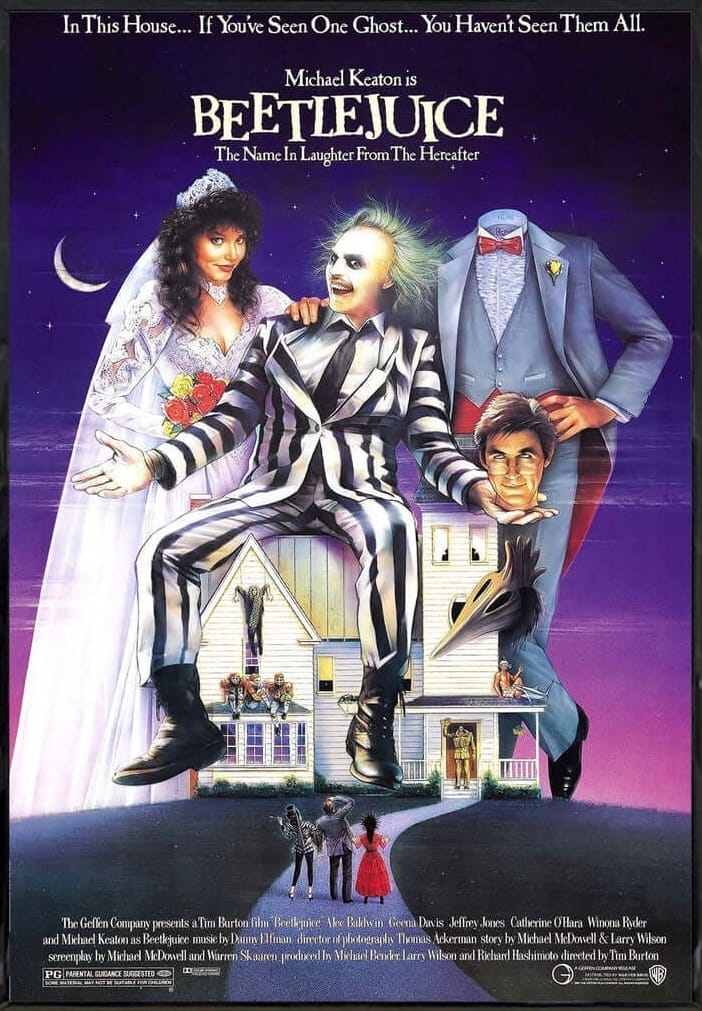
After Barbara and Adam Maitland die in a car accident, they become ghosts in their newly completed dream home in the Connecticut countryside. Unable to leave the house, they can only watch helplessly as the unbearably "arty" Deetzes, along with their goth teen dream daughter Lydia in tow, buy the home, and begin turning it into a monument to horrible art. Resolved to restore their dream home to how it was when they were still alive, the Maitlands attempt to scare the Deetzes away by haunting them, only to have their failures attract the attention of a spirit known as Betelgeuse, but his "help" quickly turns dangerous for the Maitlands, and especially for Lydia.
I have yet to watch the recent sequel to this film–titled Beetlejuice Beetlejuice, which makes me hope there's a third film that continues the naming pattern–but in the meantime, I thought I'd revisit the original.
My main takeaway from watching this film again, Tim Burton's sophmore directorial effort, after maybe not seeing it for decades, is how much of a "Burton" style film it is. This movie was made right when he was first reaching the height of his power and culture cache, and you can clearly see him settling into his signature style here, complete with a Pee Wee’s Playhouse aesthetic and a Danny Elfman Simpsons-esque score. If someone were to make a parody Burton movie, it would basically just be Beetlejuice.
The plot is fairly simple...

A shockingly young Geena Davis and Alec Baldwin are a pair of recently new ghosts. This kind of sucks, of course, as they had their whole lives ahead of them, and they also died in a really stupid way involving an inexplicable skid-out in their car within a quaint covered bridge, that looks like it's no more than 20 feet above a pretty normal looking river, into which they then fell, in their car, after a random dog basically condemned them to death.
But on the other hand... it isn't such a bad thing either. They're together, and also their spirits are now bound to their house. When they were alive, this house had been their Blue Ducks and Country Hearts L.L. Bean-draped dream home. Now they can spend eternity in the exact environment they always wanted in life.
So at least they have that going for them.
Still, being bound to the house does also mean that they are trapped in it. They soon find that not only are they unable to leave, but every door out actually leads them to a Jodorowsky’s Dune-type wasteland, an alien eternity of strange desert vistas, twisted rocky out-croppings, and endless nothing, where giant red planets hang low on the horizon, and Shai-Hulud sifts through the sands of time, ready to devour any errant soul who dares to wander in the spaces in-between worlds...
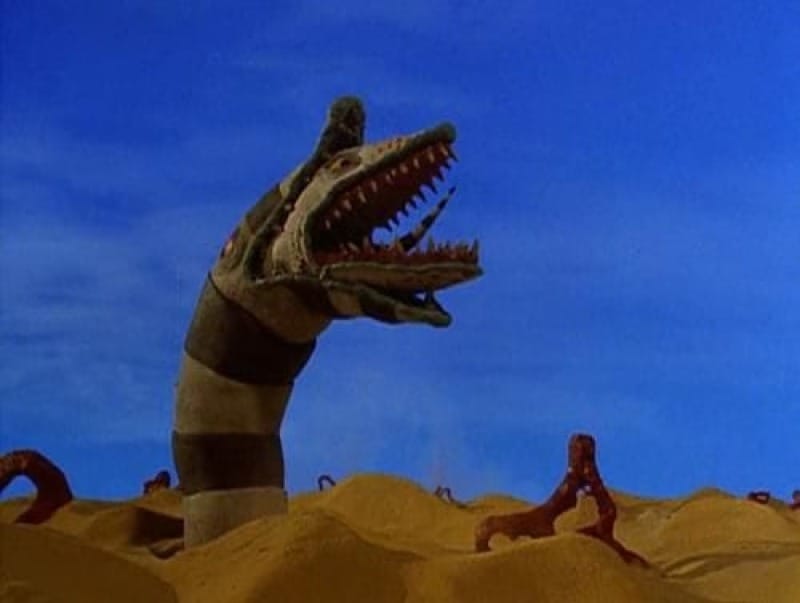
Every door out leads here, that is, but one...
The frustrated pair of newly-deads soon find a manual in their house. Titled The Handbook for the Recently Deceased, it is a hefty tome written in a style similar to unclear technical directions. The manual not only instructs them on how to live as ghosts, but also lets them know that if they have any questions, or need any help at all, they can simply scratch an outline of a door on the wall, and it will open onto what is implied to be Purgatory, but since it seems to be set up a lot like the DMV or a Public Assistance Office, it seems more like Hell to me.
But, since Barbara and Adam were a couple of well-off white people when they were alive, they head through the door, determined to speak with the Manager of the Afterlife, as they are not happy with how things turned out. Specifically, they are unhappy that a new and even more terrible family of white people have moved into their Eddie Bauer White Flight Edition Conneticut Countryside Home, and are turning it into a showcase of the ugliest parody of modern art taste that Tim Burton can envision.
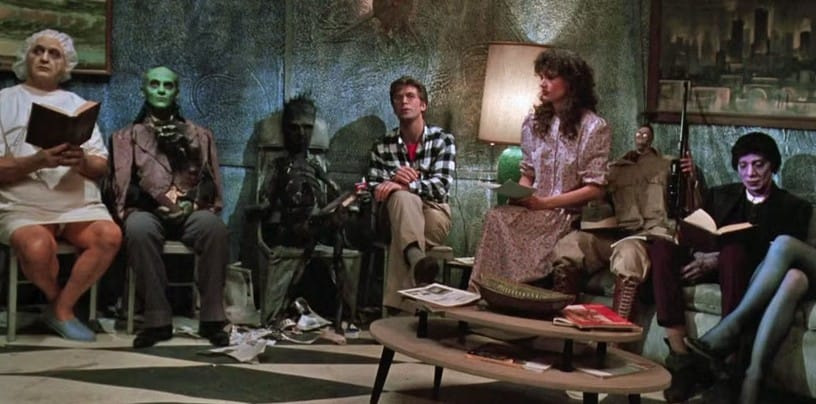
A minor plothole for me...
If in this particular version of the Afterlife, you simply carry on for eternity looking exactly like you did at the moment of your death, then why aren't the Maitlands all puffy and pale and waterlogged? They died upside down, in their car, submerged in a river, right? I once saw a dead guy who had been floating in the ocean for a good bit, and he was all saggy and bloated, and had the same orangey-pale coloring of a Jack O’Lantern that had been left on the front porch for too long. I mean, I know why they don't look all fucked-up, the meta reasons why, but it still stands out, especially in the Afterlife scenes, where everyone else apparently died in the most horrible ways possible.
So, anyway, finding themselves now in the waiting room of the Afterlife, surrounded by dozens of other recently dead folk, the Maitlands take a number and patiently wait for their turn. This is, of course, the one thing in this film that–after a lifetime of having worked customer service jobs–just doesn't seem very believable, if you ask me.
But I digress...
After some more hilarity ensues, it turns out that Barbara and Adam, dressed in their nice plaid shirts and khakis, and their flowy gingham dresses, just aren’t the haunting type. As their failures at being even remotely scary pile up, even with the help of the lovely Winona Ryder, who plays the beloved dark queen of the local Hot Topic, Lydia Deetz, the Maitlands finally turn to the film's star, a demonic spirit called Betelgeuse.
Betelgeuse–derived from the Arabic "Yad al-Jawza" meaning "the hand of al-Jawza" which is the constellation of Orion, as it was named by pre-Islamic Arabic astronaumers–is a spirit who specializes in “exorcisms of the living” from houses. The Maitlands enlist his help in getting rid of the Deetzes, but he turns out to be a bit more trouble than he's worth, especially when he decides he and Lydia need to get married. And so, more hilarity ensues, through the climax, and onto the denouement.
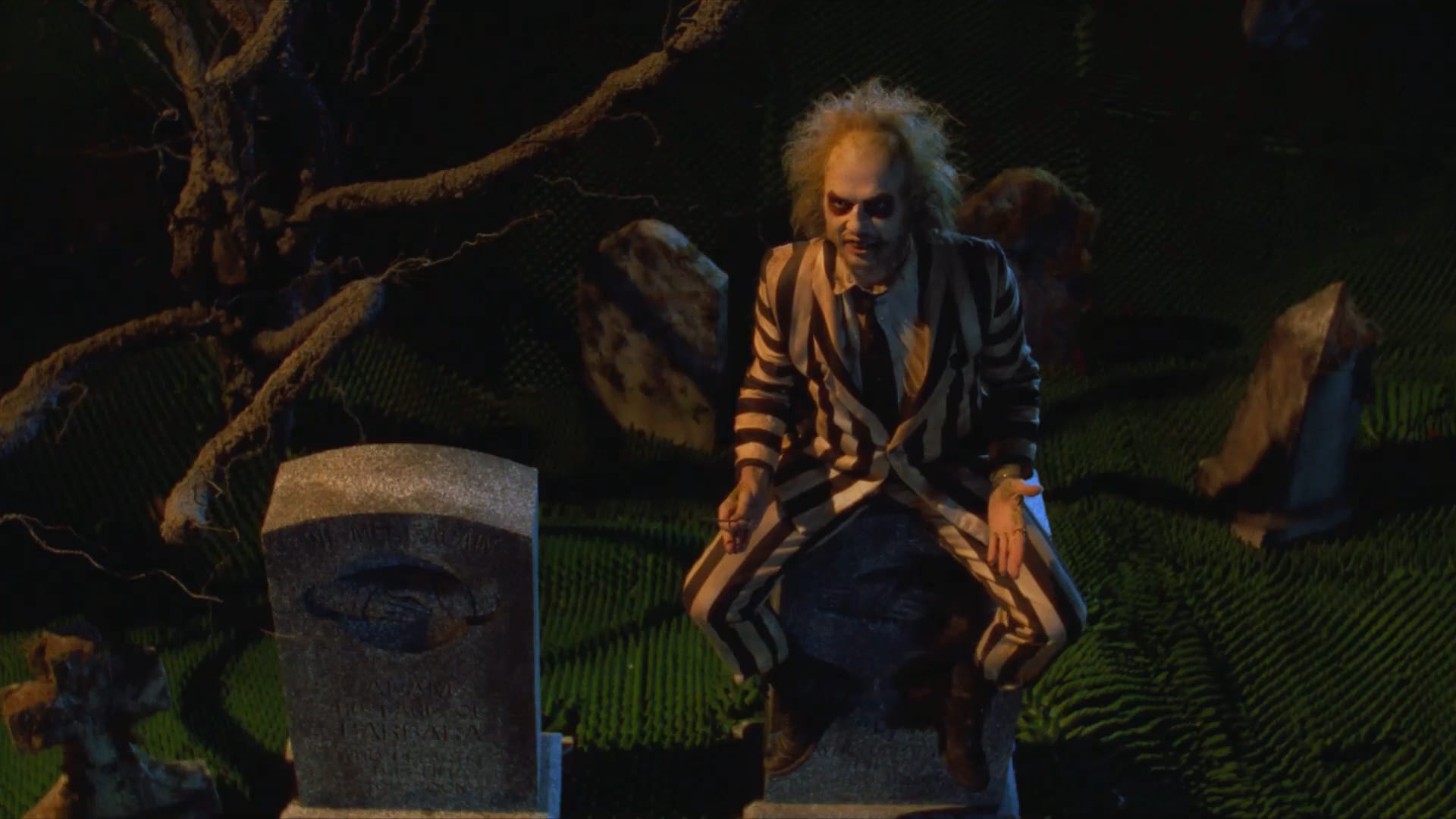
Beetlejuice was originally released in 1988, but despite only being 36 years old, there's a lot of strange realizations you get when you revisit beloved old comedies like this, especially when they turn out to be much older culturally than they are in years. Films like this are always an interesting window into not only what people thought was funny at the time, but also into the way they told stories then.
The main thing you'll notice is the rush. There are also a ton of really intriguing ideas in this film, but it burns through them like a god damn rocket, just racing past shit, and all while introducing a ton of other new and interesting ideas along the way. Most of the actually interesting ideas hers, like the Jodorowsky's Desert Afterlife, are almost completely unexplored, and are mostly treated like bits of window dressing in the background, nothing but a quick peek as you zoom past.
I mean, besides the obivious reference to The Fly, there seems to be several Dune references too, especially the ending.
What's that about?
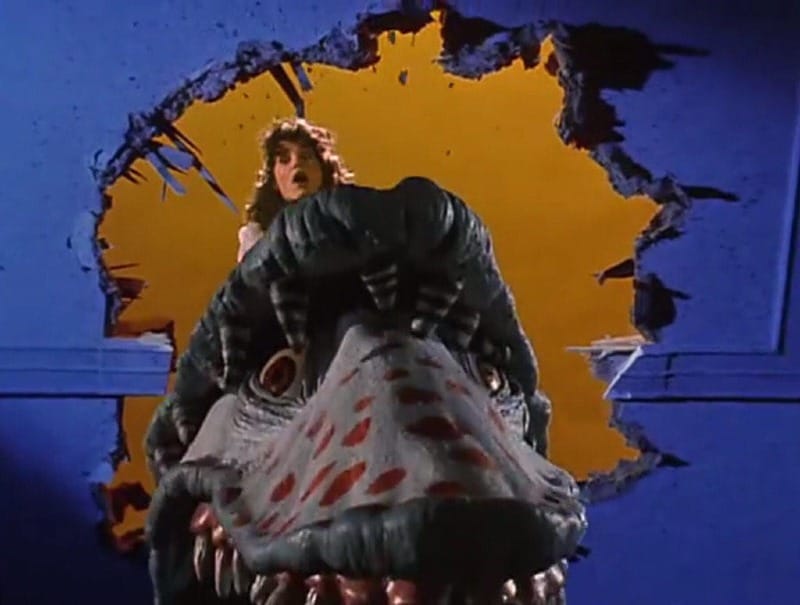
Is Barbara the Kwisatz Haderach? Do we ever find out? Does the sequel address any of this? I suppose I'll find out whether it does or not eventually. Maybe.
Probably not.
Plus, this is only a 91 minute movie, which is so short, and yet, Betelgeuse the character doesn’t truly show up until the 47 minute mark. The 47 minute mark in a 91 minute movie! And that's counting end credits. And once he does show up, he only has about 17 minutes of screentime total. 17 minutes! And yet, he's the title character, not to mention the marquee one, and the one they made dolls of, and a cartoon too. Of course, that's because he's also the most interesting character in the film. The simple fact is, no one in the film is putting on a performance at the same level as Keaton is.
Additionally, besides being kind of typically 1980s gross and insensitive, like saying outright that people who commit suicide are condemned to the hell of being civil servants forever in the Afterlife, Betelgeuse is... pretty rapey.
Lydia Deetz’s age is never explicitly stated, but it's pretty clear that she's supposed to be about 16 or so. And sure, sure, much like with Buffy and Angel, or with Buffy and Spike, the fact that their age difference is hundreds of years does make any complaints about the whole gross older man/younger woman thing to be a bit silly, but its still really creepy in the way he tries to coerce her into marrying him, the way he hangs on her, the way he threatens her, directly and implicitly, and the way he basically sexually assaults her throughout the film.
Granted, the movie definitely does not treat the idea of Lydia marrying Betelgeuse as a good thing (although, if I recall right, the Saturday morning cartoon basically made them into boyfriend and girlfriend), the film treats it as gross, slimy, and an all around horrible idea, but also, the entire interaction is used as comedic fodder, like it's a lighthearted bit of "dark" comedy, like "oh, that rascal, he's incorrigible!" in an endearing, enabling kind of way. So even with the supernatural elements and the clear depiction in the story that their marriage is a bad idea, it's still really creepy in a gross real world way.
So, that's kind of weird to watch now, but then, that's the 80s right? Romantic relationships that were built solely off of sexual assault were pretty common in comedies back them. John Hughes basically built a career off the idea.
And speaking of sexual assault, there's also the issue of Jeffrey Jones, who plays Charles Deetz, being in this film, as he is in so many 80s comedy classics. In 2003, he was charged with soliciting a minor to pose for nude photos, and has since been arrested for failing to update his sex offender status. So... his gross presense kind of makes for a shitty rewatch experience too.
On top of all that, living in the world we live in now, the "charm" of the little Conneticut small town the Maitlands live in, is a little thin. There's the nosy realtor lady who's entire character schtick in the film is that she is always trying to sell the Maitlands' house out from under them, because “it’s too big for them, and it should go to a couple with a family” and this is treated as a somewhat awkward but still endearing foible that the Maitlands endure because she's "nice", instead of treating her like a loud mouth evil bitch who needs to fuck off. Then there's the senile old barber sitting in front of his shop, just sitting there and mumbling about assaulting "hippies" and the film treats that like "Oh, that harmless old kook, he's so quirky." So, not only does this kind of shit highlight the common cultural mandate of White America to quietly enable terrible people rather than confronting them for being assholes, because rocking the boat is the worst sin imaginable–otherwise know as a big part of why we're all fucked now–there's an undeniably threatening air that seems to happily lack self-awareness just as much as it is a deliberately pointed warning to all those who "don't belong." And nothing sucks more than having the reality that accompanies finding yourself in a "nice" rural areas these days played out before you as comedic whimsy while you're trying to relax at home. Couple that shit with the fact that Betelgeuse is a lot more “sexual-assaulty” than I remember, and it's fair to say that the film has definitely lost some its shine in the intervening years.
Still, at the same time, this obviously isn't the film's intent. That doesn't forgive any of its bullshit, of course, but it's a product of its time, so what are ya' gonna do, right? I mean, besides never revisit it again? At the very least, it can be interesting and educational to revisit these products of a fairly recent era, and see just how much, and how little, has actually changed these days.
In the end... this is not my favorite Winona Ryder. My favorite Winona Ryder is obviously Reality Bites. Just FYI.
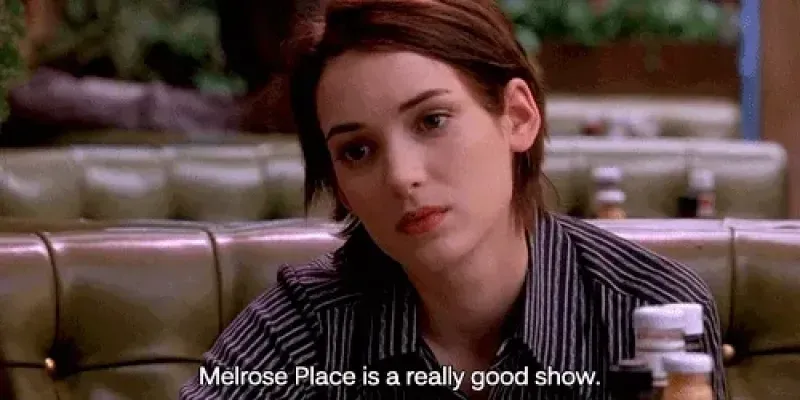
So true.
